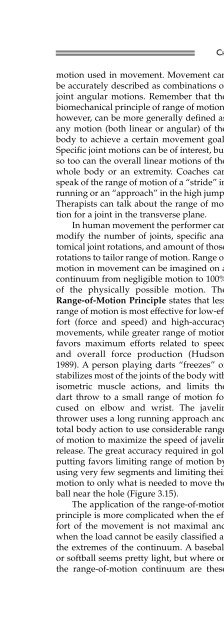Fundamentals of Biomechanics
Fundamentals of Biomechanics
Fundamentals of Biomechanics
Create successful ePaper yourself
Turn your PDF publications into a flip-book with our unique Google optimized e-Paper software.
motion used in movement. Movement can<br />
be accurately described as combinations <strong>of</strong><br />
joint angular motions. Remember that the<br />
biomechanical principle <strong>of</strong> range <strong>of</strong> motion,<br />
however, can be more generally defined as<br />
any motion (both linear or angular) <strong>of</strong> the<br />
body to achieve a certain movement goal.<br />
Specific joint motions can be <strong>of</strong> interest, but<br />
so too can the overall linear motions <strong>of</strong> the<br />
whole body or an extremity. Coaches can<br />
speak <strong>of</strong> the range <strong>of</strong> motion <strong>of</strong> a “stride” in<br />
running or an “approach” in the high jump.<br />
Therapists can talk about the range <strong>of</strong> motion<br />
for a joint in the transverse plane.<br />
In human movement the performer can<br />
modify the number <strong>of</strong> joints, specific anatomical<br />
joint rotations, and amount <strong>of</strong> those<br />
rotations to tailor range <strong>of</strong> motion. Range <strong>of</strong><br />
motion in movement can be imagined on a<br />
continuum from negligible motion to 100%<br />
<strong>of</strong> the physically possible motion. The<br />
Range-<strong>of</strong>-Motion Principle states that less<br />
range <strong>of</strong> motion is most effective for low-effort<br />
(force and speed) and high-accuracy<br />
movements, while greater range <strong>of</strong> motion<br />
favors maximum efforts related to speed<br />
and overall force production (Hudson,<br />
1989). A person playing darts “freezes” or<br />
stabilizes most <strong>of</strong> the joints <strong>of</strong> the body with<br />
isometric muscle actions, and limits the<br />
dart throw to a small range <strong>of</strong> motion focused<br />
on elbow and wrist. The javelin<br />
thrower uses a long running approach and<br />
total body action to use considerable range<br />
<strong>of</strong> motion to maximize the speed <strong>of</strong> javelin<br />
release. The great accuracy required in golf<br />
putting favors limiting range <strong>of</strong> motion by<br />
using very few segments and limiting their<br />
motion to only what is needed to move the<br />
ball near the hole (Figure 3.15).<br />
The application <strong>of</strong> the range-<strong>of</strong>-motion<br />
principle is more complicated when the effort<br />
<strong>of</strong> the movement is not maximal and<br />
when the load cannot be easily classified at<br />
the extremes <strong>of</strong> the continuum. A baseball<br />
or s<strong>of</strong>tball seems pretty light, but where on<br />
the range-<strong>of</strong>-motion continuum are these<br />
CHAPTER 3:ANATOMICAL DESCRIPTION AND ITS LIMITATIONS 61<br />
Figure 3.15. Very accurate movements like putting in<br />
golf limit range <strong>of</strong> motion by freezing most segments<br />
and using only a few segments. Photo courtesy <strong>of</strong> Getty<br />
Images.<br />
intermediate load activities? How much<br />
range <strong>of</strong> motion should you use when the<br />
load is a javelin, a shot, or your bodyweight<br />
(vertical jump)? Biomechanical studies can<br />
help kinesiology pr<strong>of</strong>essionals decide how<br />
much range <strong>of</strong> motion is “about right.” In<br />
the qualitative analysis <strong>of</strong> movement, this<br />
approach <strong>of</strong> identifying a range <strong>of</strong> correctness<br />
(like in range <strong>of</strong> motion) is quite useful<br />
because the pr<strong>of</strong>essional can either reinforce<br />
the performer's good performance, or<br />
suggest less or more range <strong>of</strong> motion be<br />
used (Knudson & Morrison, 2002). The continuum<br />
<strong>of</strong> range <strong>of</strong> motion can also be qualitatively<br />
evaluated as a sliding scale (Knudson,<br />
1999c) or volume knob (Hudson, 1995)<br />
where the performer can be told to fine<br />
tune range <strong>of</strong> motion by feedback (Figure<br />
3.16). Let's look at how biomechanical research<br />
can help pr<strong>of</strong>essionals evaluate the<br />
range <strong>of</strong> motion in a vertical jump.<br />
The amount and speed <strong>of</strong> countermovement<br />
in a vertical jump is essential to<br />
a high jump. This range-<strong>of</strong>-motion variable






